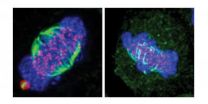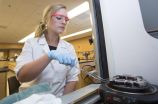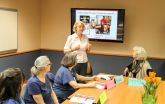INFORMATION:
Media contacts:
Associate Professor Vartanian: + 612 9385 8758, l.vartanian@unsw.edu.au
UNSW Science media officer: Deborah Smith: + 612 9385 7307, + 61478 492 060, deborah.smith@unsw.edu.au
Dine with a light eater if you want to consume less
2015-05-11
(Press-News.org) How much food your dining companion eats can have a big influence on how much you consume, a UNSW Australia-led study concludes.
This psychological effect, known as social modelling, leads people to eat less than they normally would if alone when their companion consumes a small amount of food.
Study lead author, Associate Professor Lenny Vartanian of the UNSW School of Psychology, says that in social situations the appropriate amount of food to eat can be unclear.
"Internal signals like hunger and feeling full can often be unreliable guides. In these situations people can look to the example of others to decide how much food they should consume," he says.
Associate Professor Vartanian and his colleagues analysed the results of 38 studies in which the amount of food that people ate in company was measured. The results are published in the journal Social Influence.
"The research shows that social factors are a powerful influence on consumption. When the companion eats very little, people suppress their food intake and eat less than they normally would if alone," he says.
"If the social model eats a large amount, people have the freedom to eat their normal intake, or even more if they want."
The effect is observed in many different situations: with healthy and unhealthy snack foods, during meals, when the diner has been deprived of food for up to day, and among children, and it occurs independent of people's body weight.
"It even occurs when the companion is not physically present and diners are simply given a written indication of what that other person ate," says Associate Professor Vartanian.
The effect appears to be stronger in women than men, and this may be because women tend to be more concerned about how they are viewed by others when they are eating.
"Or the explanation could be more mundane, that undergraduate males participating in the research are over-enthusiastic about an offer of free food," he says.
The research shows that the modelling effect is stronger in older children than in younger children, which also suggests that relying on external rather than internal cues for how much to eat is a learnt behaviour.
"Media reports usually focus on how portion size affects how much we eat, but this modelling effect deserves as much attention, because of its big impact on people's ability to regulate their intake of food," says Associate Professor Vartanian.
ELSE PRESS RELEASES FROM THIS DATE:
Leicester research team identifies potential new targets for cancer treatments
2015-05-11
An international consortium of scientists led by a group from the University of Leicester has announced a new advance in understanding the mechanisms of cancer and how to target it more effectively with new treatments.
Two papers published in the same issue of the world-leading Journal of Cell Biology have arisen from research work led by Professor Andrew Fry at the University of Leicester. Both papers suggest that new understanding of the mechanics of cell division can reveal new targets for cancer therapy.
Professor Fry, who is Director of Research in the College ...
The origins and future of Lake Eyre and the Murray-Darling Basin
2015-05-11
Geoscientists have, for the first time, discovered the origins of Australia's two largest basins: Lake Eyre and the Murray-Darling Basin. The research also implies that in 30 million years' time both basins will cease to exist.
Monash University geoscientist Associate Professor Wouter Schellart, and his colleague Professor Wim Spakman from Utrecht University, have discovered how the floor of an entire ocean basin that was destroyed 70 to 50 million years ago off the North coast of New Guinea is currently located at 800-1200km depth below Central and South-eastern Australia.
Using ...
Advanced MRI scans could help predict people at risk of schizophrenia
2015-05-11
New scanning methods which map the wiring of the brain could provide a valuable new tool to predict people at risk of schizophrenia, according to a new study.
Scientists have long known that the symptoms of schizophrenia are partly explained by disordered connectivity in the brain.
Now, a team of scientists from Cardiff University Brain Research Imaging Centre (CUBRIC), the Institute of Psychiatry, Psychology and Neuroscience, Kings College London and the University of Bristol, have, for the first time, used Magnetic Resonance Imaging (MRI) to identify how the ...
New study finds short-sightedness is becoming more common across Europe
2015-05-11
Myopia or short-sightedness is becoming more common across Europe, according to a new study led by King's College London. The meta-analysis of findings from 15 studies by the European Eye Epidemiology Consortium found that around a quarter of the European population is short-sighted but it is nearly twice as common in younger people, with almost half (47 per cent) of the group aged between 25 and 29 years affected.
The analysis of studies covering over 60,000 people, which was published today in the journal Ophthalmology, also found a strong link between myopia and level ...
Researchers examine the dangers bubbling up from hookah steam stones
2015-05-11
New research suggests the use of hookah steam stones - commonly considered a safer alternative to cigarette smoking - could be leaving users with a dangerous, false sense of security. The findings out of the University of Cincinnati/Agilent Technologies Metallomics Center of the Americas are published this month in the Microchemical Journal.
An analysis led by Amberlie Clutterbuck, a doctoral student in the UC Department of Chemistry, found residues of toxic metals that included chromium, arsenic and cadmium following several simulated hookah/steam stones smoking scenarios.
Clutterbuck's ...
Dopamine signals the value of delayed rewards
2015-05-11
Philadelphia, PA, May 11, 2015 -- Dopamine is the chemical messenger in the brain most closely associated with pleasure and reward. Recent scientific advances now shed light on precise roles for dopamine in the reward process.
A new paper published in the current issue of Biological Psychiatry implicates dopamine in a person's ability to be motivated by delayed rewards.
People like immediate reinforcement and tend to devalue rewards that are substantially delayed in time. As a result, people will often opt for smaller immediate rewards as opposed to larger delayed rewards ...
Advanced viral gene therapy eradicates prostate cancer in preclinical experiments
2015-05-11
Even with the best available treatments, the median survival of patients with metastatic, hormone-refractory prostate cancer is only two to three years. Driven by the need for more effective therapies for these patients, researchers at VCU Massey Cancer Center and the VCU Institute of Molecular Medicine (VIMM) have developed a unique approach that uses microscopic gas bubbles to deliver directly to the cancer a viral gene therapy in combination with an experimental drug that targets a specific gene driving the cancer's growth.
Recently published in the journal Oncotarget, ...
New method developed to assess cancer risk of pollutants
2015-05-11
CORVALLIS, Ore. - Scientists at Oregon State University have developed a faster, more accurate method to assess cancer risk from certain common environmental pollutants.
Researchers found that they could analyze the immediate genetic responses of the skin cells of exposed mice and apply statistical approaches to determine whether or not those cells would eventually become cancerous.
The study focused on an important class of pollutants known as polycyclic aromatic hydrocarbons, or PAHs, that commonly occur in the environment as mixtures such as diesel exhaust and cigarette ...
How cancer tricks the lymphatic system into spreading tumors
2015-05-11
Swollen lymph nodes are often the earliest sign of metastatic spread of cancer cells. Now cancer researchers and immunologists at Sweden's Karolinska Institutet have discovered how cancer cells can infiltrate the lymphatic system by 'disguising' themselves as immune cells (white blood cells). The researchers hope that this finding, which is published in the scientific journal Oncogene, will inform the development of new drugs.
The main reason why people die of cancer is that the cancer cells spread to form daughter tumours, or metastases, in vital organs, such as the ...
Nurses cut stress 40 percent with relaxation steps at work
2015-05-11
COLUMBUS, Ohio - A study by researchers at The Ohio State University Wexner Medical Center found that a workplace mindfulness-based intervention reduced stress levels of employees exposed to a highly stressful occupational environment.
Members of a surgical intensive care unit at the large academic medical center were randomized to a stress-reduction intervention or a control group. The 8-week group mindfulness-based intervention included mindfulness, gentle stretching, yoga, meditation and music conducted in the workplace. Psychological and biological markers of stress ...




